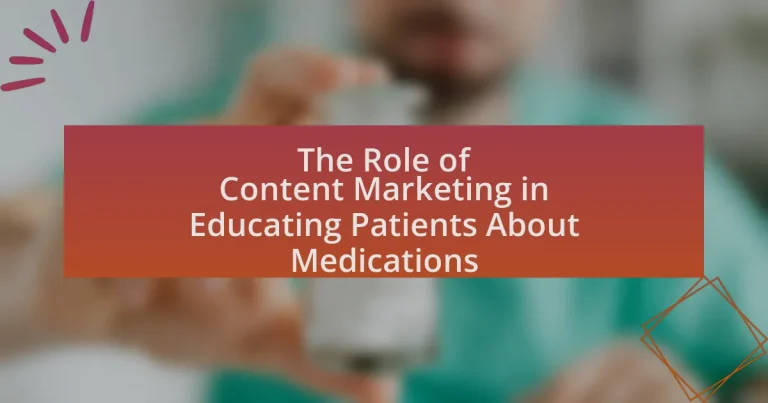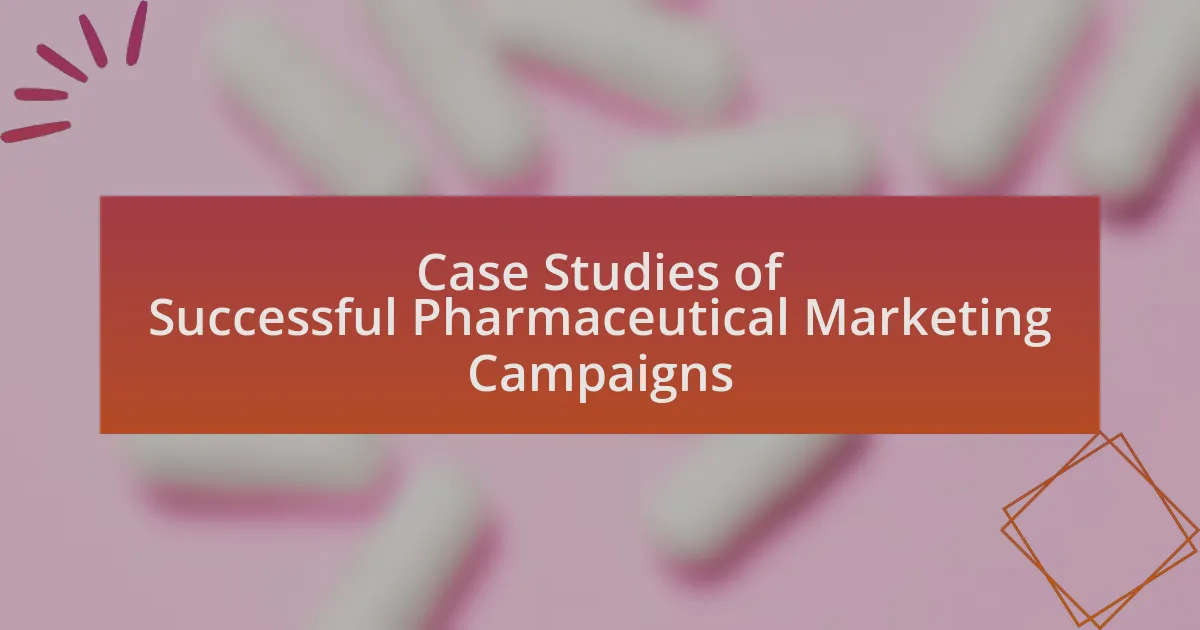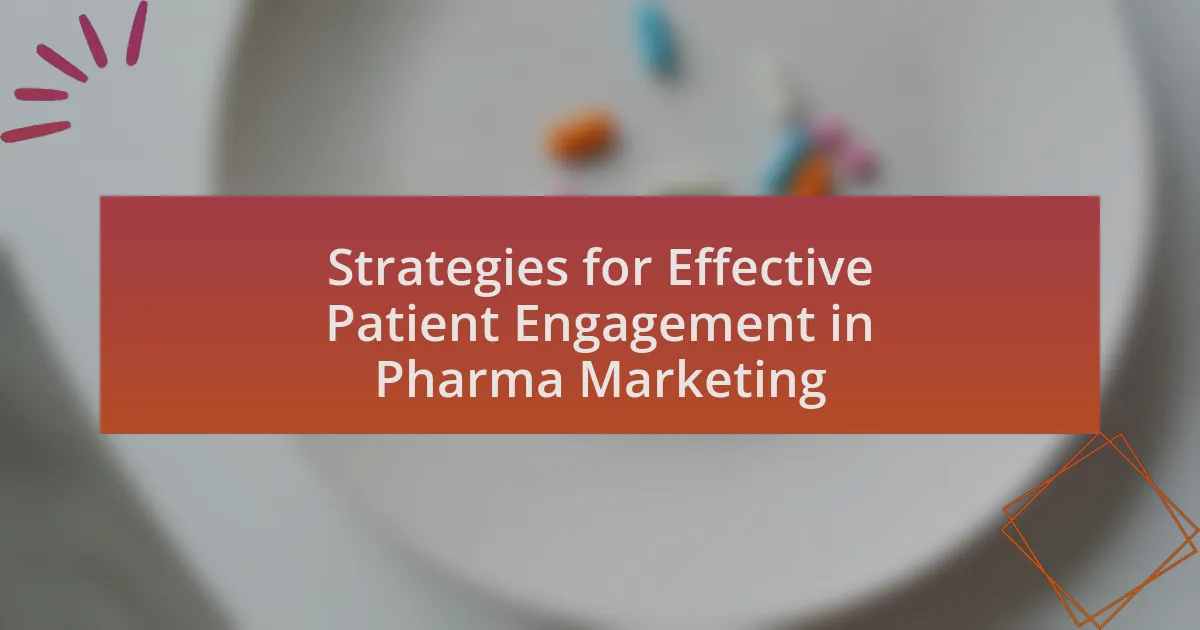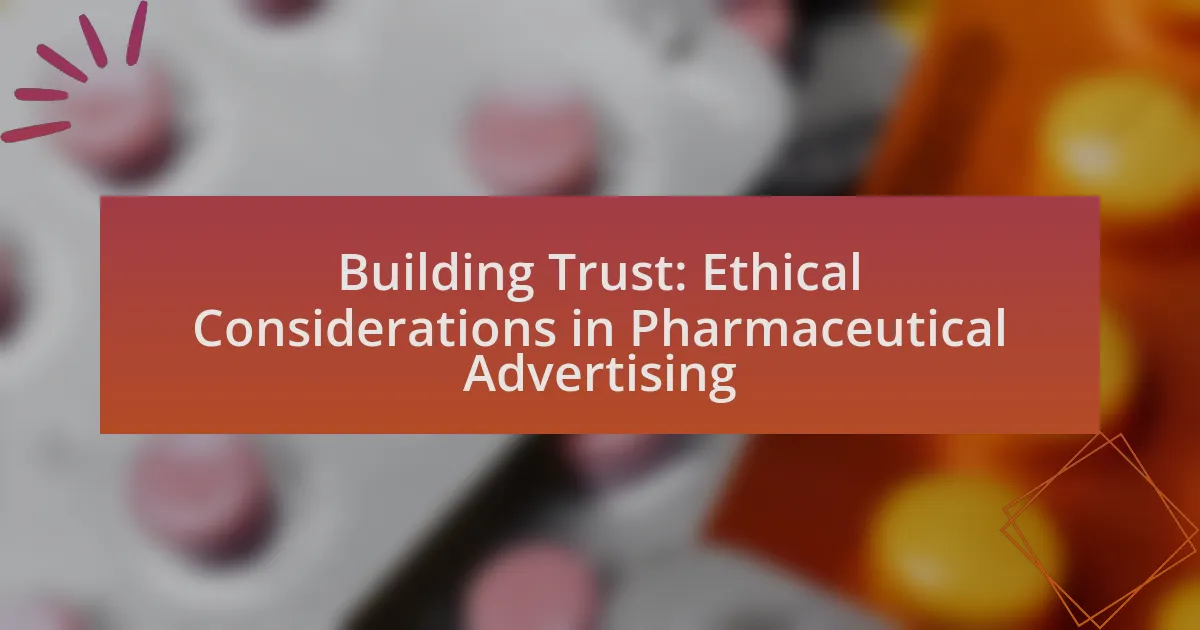The article focuses on the role of content marketing in educating patients about medications. It highlights how content marketing provides accessible, accurate, and engaging information that helps patients understand complex medical terminology and treatment options, ultimately leading to better adherence to prescribed medication regimens. The article discusses effective content formats, such as videos, articles, and infographics, and emphasizes the importance of tailoring content to diverse patient populations. Additionally, it addresses the challenges of misinformation and varying health literacy levels, while outlining strategies for healthcare providers to enhance patient engagement and trust through effective content marketing practices.
What is the Role of Content Marketing in Educating Patients About Medications?
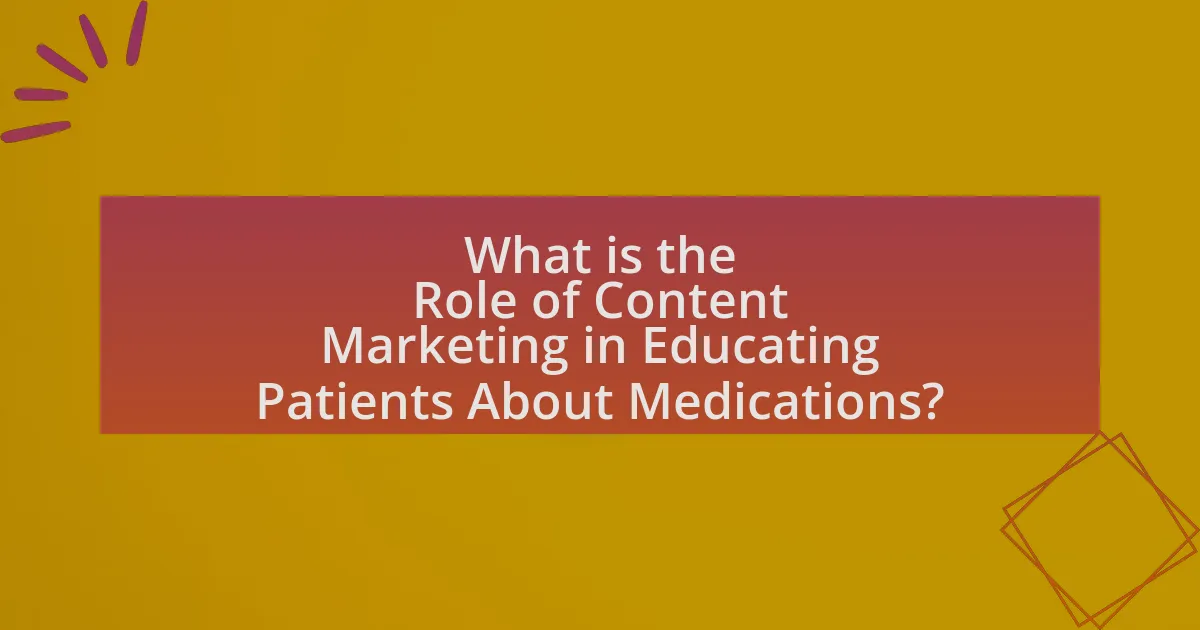
Content marketing plays a crucial role in educating patients about medications by providing accessible, accurate, and engaging information. This approach helps demystify complex medical terminology and treatment options, enabling patients to make informed decisions regarding their health. For instance, studies show that patients who engage with educational content are more likely to adhere to prescribed medication regimens, as they better understand the benefits and potential side effects. Furthermore, content marketing strategies, such as blogs, videos, and social media posts, can reach diverse audiences, ensuring that vital information is disseminated widely and effectively.
How does content marketing facilitate patient education regarding medications?
Content marketing facilitates patient education regarding medications by providing accessible, accurate, and engaging information tailored to patients’ needs. This approach allows healthcare providers and organizations to create informative content, such as articles, videos, and infographics, that explain medication usage, side effects, and adherence strategies. Research indicates that patients who engage with educational content are more likely to understand their treatment plans and adhere to prescribed medications, leading to improved health outcomes. For instance, a study published in the Journal of Medical Internet Research found that patients who accessed online educational resources reported higher medication adherence rates compared to those who did not.
What types of content are most effective for educating patients?
Visual content, such as infographics and videos, is most effective for educating patients. Research indicates that visual aids can enhance understanding and retention of medical information, with studies showing that people retain 65% of information when paired with relevant visuals compared to only 10% when presented in text alone. Additionally, interactive content, like quizzes and simulations, engages patients actively, leading to better comprehension and application of knowledge.
How do different formats (videos, articles, infographics) impact patient understanding?
Different formats such as videos, articles, and infographics significantly impact patient understanding by catering to diverse learning preferences and enhancing information retention. Research indicates that videos can improve comprehension by up to 80% compared to text alone, as they combine visual and auditory elements, making complex information more accessible. Articles provide in-depth explanations and allow for detailed exploration of topics, which can be beneficial for patients seeking comprehensive knowledge. Infographics, on the other hand, present information in a visually engaging manner, facilitating quicker understanding and recall of key concepts. A study published in the Journal of Medical Internet Research found that patients who engaged with infographics demonstrated a 50% increase in understanding medication instructions compared to those who only read text. Thus, utilizing a mix of these formats can optimize patient education and enhance overall understanding of medications.
Why is patient education about medications important?
Patient education about medications is important because it enhances adherence to treatment regimens and improves health outcomes. When patients understand their medications, including their purpose, dosage, and potential side effects, they are more likely to take them as prescribed. Research indicates that effective patient education can lead to a 50% increase in adherence rates, significantly reducing the risk of complications and hospitalizations. Furthermore, informed patients are better equipped to manage their health, leading to improved overall well-being and reduced healthcare costs.
What are the potential consequences of inadequate medication education?
Inadequate medication education can lead to serious health consequences, including medication errors, non-adherence to treatment regimens, and increased hospitalizations. Patients who lack proper understanding of their medications may misuse them, resulting in adverse drug reactions or ineffective treatment. Research indicates that nearly 50% of patients do not take their medications as prescribed, often due to misunderstanding instructions or the purpose of the medication. This non-adherence can exacerbate health conditions, leading to higher healthcare costs and poorer health outcomes. Furthermore, inadequate education can contribute to a lack of patient engagement in their own care, diminishing the effectiveness of treatment plans and overall patient satisfaction.
How does informed patient education improve health outcomes?
Informed patient education improves health outcomes by enhancing patients’ understanding of their conditions and treatment options, leading to better adherence to medical advice and improved self-management. Studies indicate that patients who receive comprehensive education about their medications are more likely to follow prescribed regimens, resulting in a 50% increase in adherence rates. This increased adherence directly correlates with reduced hospitalizations and better management of chronic diseases, as evidenced by research published in the Journal of Managed Care & Specialty Pharmacy, which found that effective patient education can lead to a 30% reduction in healthcare costs.
What strategies are used in content marketing for medication education?
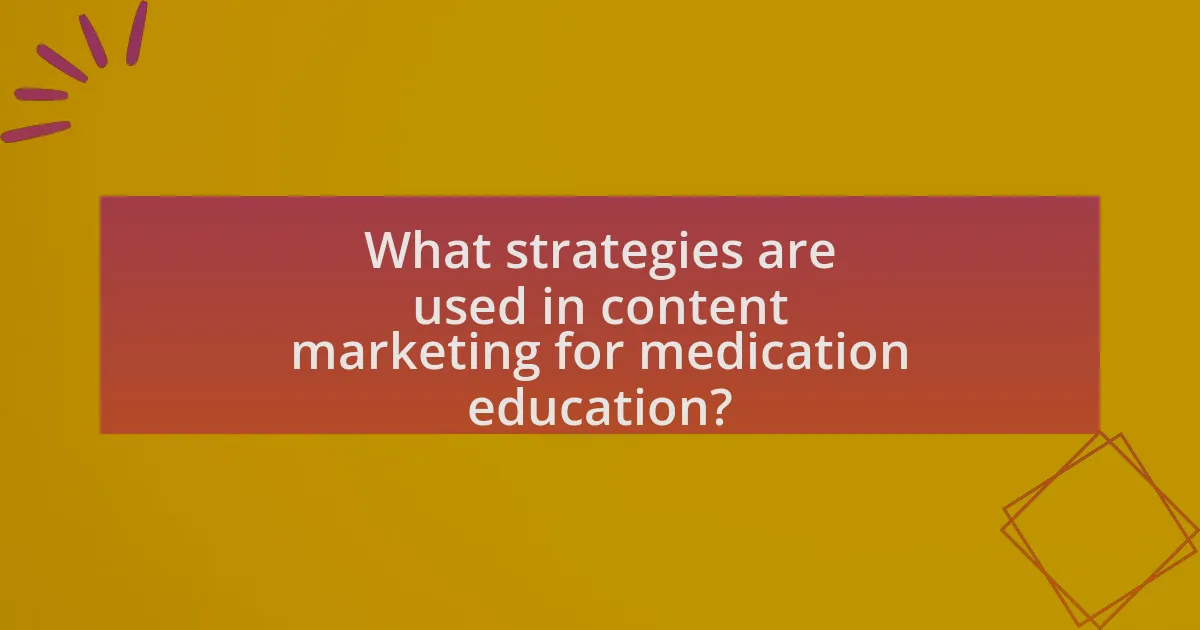
Content marketing for medication education employs strategies such as creating informative blog posts, utilizing social media platforms, and producing engaging video content. These strategies aim to enhance patient understanding of medications, ensuring they receive accurate and accessible information. For instance, blog posts can provide detailed explanations of medication uses, side effects, and interactions, while social media can facilitate real-time engagement and community support. Video content, such as tutorials or patient testimonials, can visually demonstrate medication administration and share personal experiences, making the information more relatable. These approaches have been shown to improve patient knowledge and adherence to medication regimens, as evidenced by studies indicating that well-informed patients are more likely to follow prescribed treatments effectively.
How can healthcare providers create engaging content for patients?
Healthcare providers can create engaging content for patients by utilizing clear, relatable language and incorporating multimedia elements such as videos and infographics. This approach enhances understanding and retention of information regarding medications. Research indicates that patients are more likely to engage with content that is visually appealing and easy to comprehend, as evidenced by a study published in the Journal of Medical Internet Research, which found that multimedia content significantly improved patient knowledge and satisfaction. Additionally, tailoring content to address specific patient concerns and preferences fosters a more personalized experience, further increasing engagement.
What role does storytelling play in patient education content?
Storytelling plays a crucial role in patient education content by enhancing engagement and retention of information. When patients are presented with narratives that relate to their experiences, they are more likely to connect emotionally and understand complex medical concepts. Research indicates that stories can improve recall by up to 65% compared to traditional informational formats, as they create relatable contexts that facilitate learning. This method not only aids in comprehension but also empowers patients to make informed decisions about their health, ultimately leading to better health outcomes.
How can healthcare providers ensure content is accessible and understandable?
Healthcare providers can ensure content is accessible and understandable by using plain language, visual aids, and culturally relevant examples. Plain language simplifies complex medical terminology, making it easier for patients to grasp essential information. Research indicates that using plain language can improve patient comprehension by up to 80%. Visual aids, such as infographics and diagrams, enhance understanding by providing visual context, which is particularly effective for individuals with varying literacy levels. Additionally, incorporating culturally relevant examples ensures that the content resonates with diverse patient populations, thereby increasing engagement and comprehension.
What platforms are most effective for distributing educational content?
The most effective platforms for distributing educational content include social media, websites, email newsletters, and online learning management systems. Social media platforms like Facebook and Twitter facilitate wide reach and engagement, allowing for real-time interaction and sharing of educational materials. Websites serve as centralized hubs for content, providing detailed information and resources. Email newsletters enable direct communication with targeted audiences, ensuring that educational content reaches individuals who have expressed interest. Online learning management systems, such as Moodle and Canvas, offer structured environments for delivering comprehensive educational programs. These platforms collectively enhance accessibility and engagement, making them vital for effective educational content distribution.
How do social media channels enhance patient engagement with medication information?
Social media channels enhance patient engagement with medication information by providing accessible platforms for real-time communication and information sharing. These channels facilitate direct interaction between healthcare providers and patients, allowing for immediate responses to medication-related inquiries. Research indicates that 72% of internet users seek health information online, with social media serving as a key resource for medication education and support. Additionally, social media fosters community building, where patients can share experiences and advice, further enriching their understanding of medications. This interactive environment not only increases awareness but also encourages adherence to prescribed treatments, as patients feel more connected and informed.
What are the benefits of using email newsletters for patient education?
Email newsletters provide several benefits for patient education, including improved information dissemination, enhanced patient engagement, and increased accessibility to health resources. These newsletters allow healthcare providers to deliver tailored content directly to patients’ inboxes, ensuring that important information about medications, treatment options, and health tips reaches them in a timely manner. Research indicates that personalized communication can lead to better health outcomes, as patients who receive relevant information are more likely to adhere to treatment plans. Furthermore, email newsletters can be accessed at the patient’s convenience, allowing them to review materials at their own pace, which is particularly beneficial for complex medical topics.
What challenges exist in using content marketing for patient education?
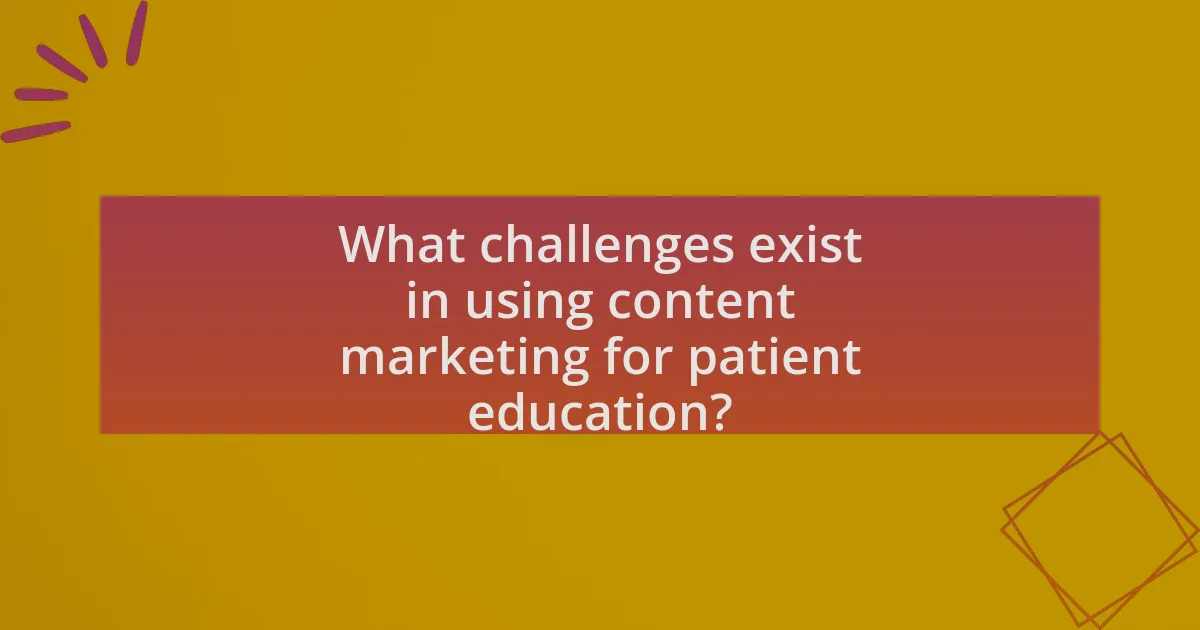
Content marketing for patient education faces several challenges, including information overload, varying health literacy levels, and regulatory compliance. Information overload occurs when patients are inundated with excessive content, making it difficult for them to discern relevant information. Varying health literacy levels among patients can lead to misunderstandings or misinterpretations of medical information, which can hinder effective education. Additionally, regulatory compliance poses a challenge, as content must adhere to guidelines set by organizations such as the FDA, which can restrict the types of claims that can be made in educational materials. These challenges necessitate careful planning and execution to ensure that content marketing effectively educates patients about medications.
How can misinformation in content marketing be addressed?
Misinformation in content marketing can be addressed by implementing fact-checking protocols and utilizing credible sources. Establishing a rigorous review process that includes verification of facts from reputable medical organizations, such as the American Medical Association, ensures that the content is accurate. Additionally, training content creators on the importance of evidence-based information can further reduce the spread of misinformation. Research indicates that 80% of consumers are more likely to trust brands that provide accurate information, highlighting the necessity of maintaining credibility in content marketing.
What strategies can be implemented to verify the accuracy of medication information?
To verify the accuracy of medication information, healthcare professionals can implement strategies such as cross-referencing information with reputable sources, utilizing clinical guidelines, and engaging in peer reviews. Cross-referencing involves checking medication details against established databases like the National Library of Medicine or the FDA’s drug database, which provide reliable and updated information. Utilizing clinical guidelines from organizations such as the American Medical Association ensures that the information aligns with current best practices. Engaging in peer reviews allows for collaborative verification, where multiple experts assess the accuracy of the information, thereby enhancing its credibility. These strategies collectively ensure that medication information is accurate and trustworthy for patient education.
How can healthcare providers build trust with patients through content marketing?
Healthcare providers can build trust with patients through content marketing by delivering accurate, relevant, and empathetic information about medications and health conditions. This approach fosters transparency and positions providers as reliable sources of knowledge. For instance, studies show that 80% of patients prefer to receive health information from their healthcare providers rather than other sources, highlighting the importance of direct communication. By utilizing blogs, videos, and social media to share evidence-based content, healthcare providers can address patient concerns, clarify misconceptions, and demonstrate their commitment to patient education. This consistent engagement not only enhances patient understanding but also strengthens the provider-patient relationship, ultimately leading to increased trust.
What metrics can be used to measure the effectiveness of content marketing in patient education?
Metrics that can be used to measure the effectiveness of content marketing in patient education include engagement rates, conversion rates, and knowledge retention. Engagement rates, such as time spent on content and social media shares, indicate how well the content resonates with patients. Conversion rates measure the percentage of patients who take a desired action, such as signing up for a newsletter or scheduling an appointment, demonstrating the content’s impact on behavior. Knowledge retention can be assessed through pre- and post-education surveys, revealing how well patients understand medication information after consuming the content. These metrics provide concrete evidence of content marketing’s effectiveness in enhancing patient education.
How can engagement rates indicate the success of educational content?
Engagement rates serve as a key metric for assessing the success of educational content by reflecting how actively the audience interacts with the material. High engagement rates, such as likes, shares, comments, and time spent on content, indicate that the audience finds the information valuable and relevant. For instance, a study by HubSpot found that content with higher engagement rates leads to increased retention of information, suggesting that engaged users are more likely to absorb and apply the educational material. Therefore, tracking engagement rates provides insight into the effectiveness of educational content in achieving its intended purpose of informing and educating patients about medications.
What role do patient feedback and surveys play in evaluating content effectiveness?
Patient feedback and surveys are essential in evaluating content effectiveness as they provide direct insights into patient understanding and engagement with educational materials. By collecting data on patient perceptions, preferences, and comprehension, healthcare providers can assess whether the content meets its educational objectives. For instance, a study published in the Journal of Medical Internet Research found that patient surveys significantly improved the relevance and clarity of health information, leading to better patient outcomes. This evidence underscores the importance of integrating patient feedback into content marketing strategies to enhance the educational impact on medication use.
What best practices should be followed for effective content marketing in medication education?
Effective content marketing in medication education should prioritize clarity, accuracy, and engagement. Clear communication ensures that patients understand medication instructions and potential side effects, which is crucial for adherence and safety. Accurate information is essential, as it builds trust and credibility; for instance, content should be based on evidence from reputable sources like clinical studies or guidelines from health organizations. Engaging formats, such as videos or infographics, can enhance understanding and retention of information, as studies show that visual content is processed 60,000 times faster than text. Additionally, tailoring content to the specific needs and literacy levels of the target audience increases its effectiveness, as demonstrated by research indicating that personalized education improves patient outcomes.
How can healthcare providers tailor content to meet the needs of diverse patient populations?
Healthcare providers can tailor content to meet the needs of diverse patient populations by utilizing culturally relevant language, addressing specific health concerns prevalent in different communities, and employing various formats that cater to different learning styles. For instance, research indicates that health literacy varies significantly among populations; thus, simplifying medical jargon and using visuals can enhance understanding. Additionally, providers can analyze demographic data to identify prevalent health issues, such as diabetes in certain ethnic groups, and create targeted educational materials that resonate with those communities. This approach not only improves patient engagement but also fosters trust, as patients feel their unique backgrounds and needs are acknowledged and addressed.
What are the key elements of a successful content marketing strategy for patient education?
The key elements of a successful content marketing strategy for patient education include understanding the target audience, creating relevant and engaging content, utilizing multiple channels for distribution, and measuring the effectiveness of the content. Understanding the target audience involves identifying their needs, preferences, and challenges related to medications, which ensures that the content resonates with them. Creating relevant and engaging content means providing clear, accurate, and actionable information that empowers patients to make informed decisions about their health. Utilizing multiple channels, such as social media, websites, and email newsletters, enhances accessibility and reach, allowing patients to engage with the content in their preferred format. Measuring effectiveness through analytics and feedback helps refine the strategy, ensuring continuous improvement and alignment with patient needs.
